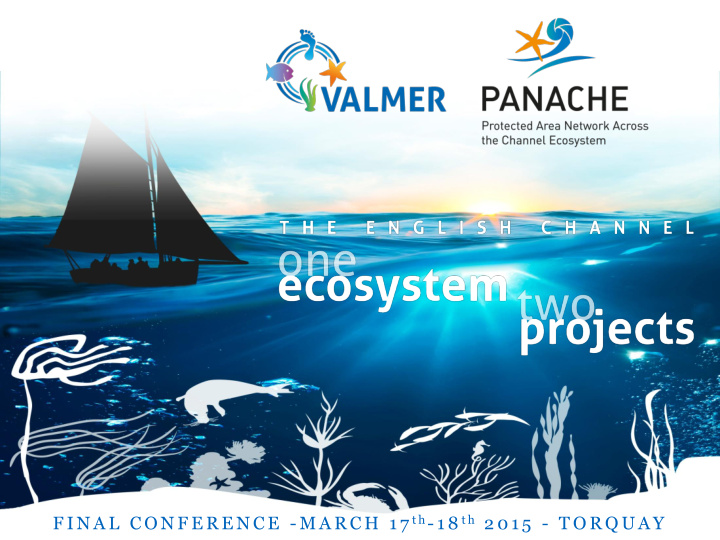



F I N A L C O N F E R E N C E - M A R C H 1 7 t h - 1 8 t h 2 0 1 5 - T O R Q U A Y
Developing management plans for cetaceans within MPAS. Ruth Williams, Marine Conservation Manager Cornwall Wildlife Trust ruth.williams@cornwallwildlifetrust.org.uk
MPAs for cetaceans – Cornwall Wildlife Trusts‘ work on mobile species What do we know – cetacean data collection (from sightings, acoustics, and strandings.) Threats and issues Potential management for their protection : - MPA’s - Bycatch mitigation 3
MPAs for mobile species…a controversial discussion!
Seaquest – ad hoc and effort based recording, and acoustic monitoring of our cetaceans
C-POD Acoustic monitoring systems full of clever software!
Marine Strandings Network - Investigating deaths of marine mammals Photo Paul Semmens
Cornwall Wildlife Trust Bycatch Evidence Evaluation Project – BEEP: Encircling marks indicative of set net entanglement
Causes of death 1990-2011 (based on necropsies) Necropsy data courtesy of CSIP
Threats • Fishing / bycatch • Mean annual spatial distribution of fisheries activity (2000 – 2004) derived from VMS records. The colour scale indicates the mean annual number of Vessel Monitoring System • Pile driving derived data points within 9 km2 pixels (From Witt & Godley, 2007). • Pollution • Disturbance • Habitat degradation How do we protect against these threats – directly or spatially?
CWT ‘Banana pinger ’ trials • To reduce accidental entanglement of cetaceans in inshore fishing nets • Fishtek Ltd ., based in Devon, developed the Banana pinger as a direct result of previous work in the Cornish fishery. • Specifically designed to meet the EU regulations on sound frequency and power as well as concentrating on reducing the cost of a unit.
SEAQUEST NETSAFE – Understanding Cornwall’s cetaceans Marine Strandings Network - Investigating deaths of marine mammals Photo Paul Semmens
• Results show a lower number of porpoise clicks from nets with pingers present than from nets without pingers. • An average reduction of porpoise click detections to 18% on pingered nets compared to non-pingered nets. • This means there is an average reduction in risk of entanglement of 82%
• Banana Pinger is practical - suitable for deployment in an inshore set net fishery • It’s effective - shows a strong ‘ pinger effect’ that can be expected to translate into a greatly reduced risk of bycatch. • No habituation or displacement issues and rapid recolonisation when pinger is off. • Good battery life and low cost
Can MPAs be used as a tool to protect cetaceans? • Knowledge of populations is essential • Species or groups with a known ‘home range’ • More mobile species with clear breeding / feeding areas • Localised threats
Do designated MPAs work for cetacean protection? Moray Firth SAC for bottlenose dolphins
An Ecologically Coherent Network of MPAs? Shouldn’t just include FOCI spp and habitats. Common dolphins by Lissa Batey • Should include: • - areas supporting particular ecological processes • - important for particular life stages or behaviours • - highly productive or supports high biodiversity
Ocean Giants campaign Megafauna hotspots The missing link in our network of Marine Protected Areas • The Wildlife Trust’s Ocean Giants campaign - mobile species to be included as features of MCZs 19
Areas of Pelagic Ecological Importance Cetacean biodiversity hotspot areas extracted from the APEI data layer
Conclusions.... • Ensure mobile species are included as features in MPAs / MCZs – high productivity / life stages / threats • Continue monitoring cetacean species distribution and population through visual and acoustic methods and feed into APEI datasets • Continue to monitor strandings to understand threats and assess CoD – indicator of key issues. • Pingers to be used on nets set within MPAs where there is high fisheries interactions.
Thank you Thank You! Ruth Williams Marine Conservation Manager , Cornwall Wildlife Trust ruth.williams@cornwallwildlifetrust.org.uk ruth.williams@cornwallwildlifetrust.org.uk
The VALMER and PANACHE projects were selected under the European cross-border cooperation programme INTERREG IV A France (Channel) - England, co-funded by the ERDF.
Recommend
More recommend